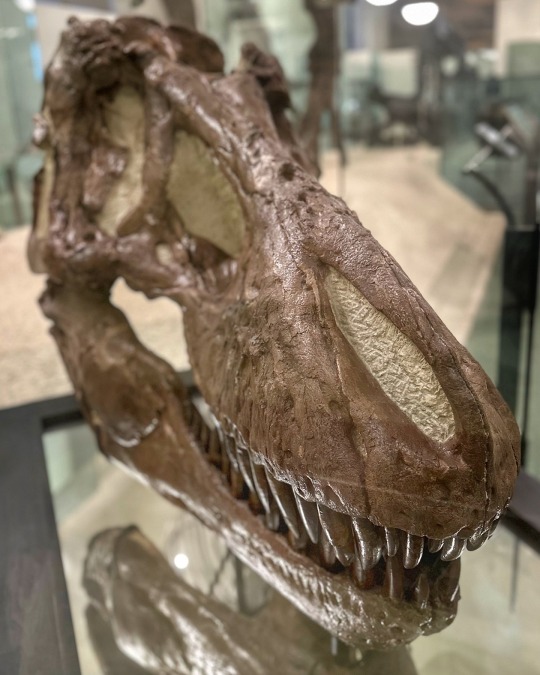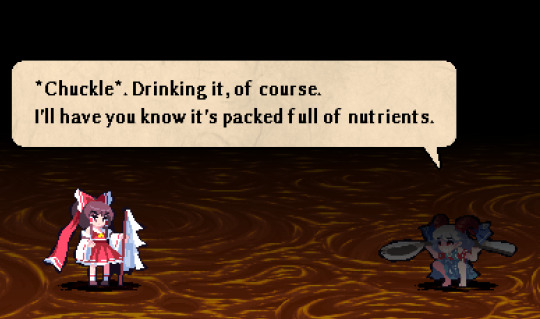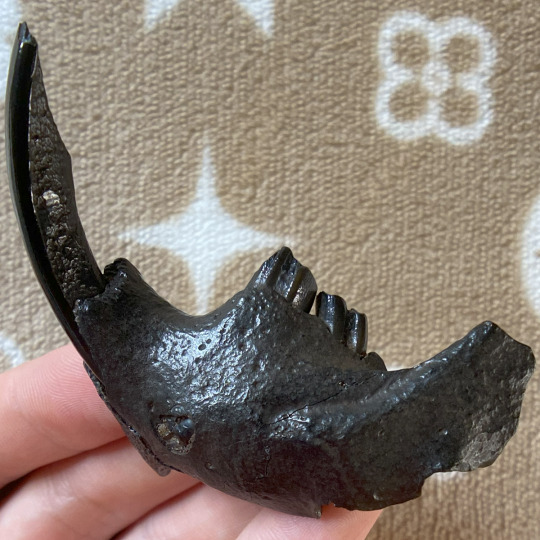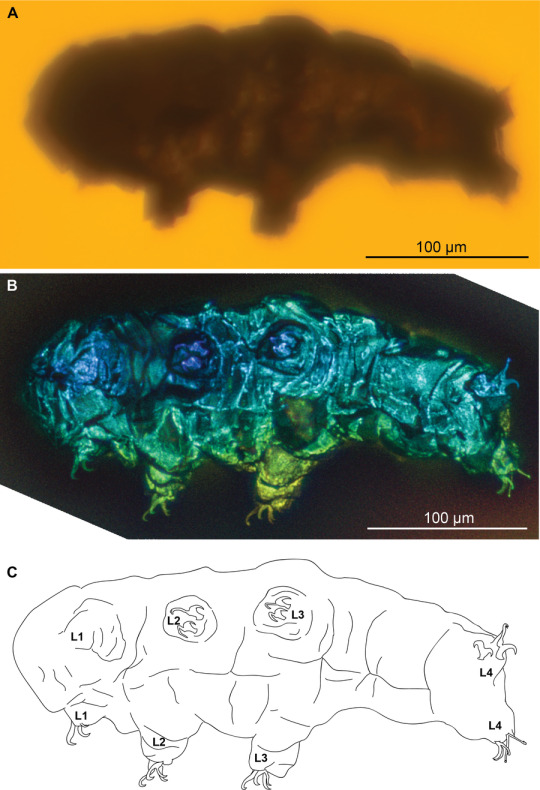#American fossils
Explore tagged Tumblr posts
Text




🐟 🌊 #3 on our top 10 finds of 2024: the stingray fossil we found at American Fossil Quarry in Green River formation, Kemmerer, Wyoming!! This ancient beauty was completely encased in a huge slab and accented by some partially exposed fish. We got the opportunity to dig American Fossil as vendors at the Kemmerer Fossil Fish Expo, a worthy trip to this neat little town. At the very end of the day, we were the last vendors digging and splitting. Keith discovered the stingray on the very last split of the day (of course, and no surprise 😅—as you know, Keith’s exceptional luck only goes up as the day progresses.)
As noob Green River diggers, we didn’t really know what we were looking at in the rock—but the experts at American Fossil sure did!! They helped identify the layout of the stingray, and told us that they expected it to be almost fully intact. Thankfully, the experts at Fossil Oasis were also on the scene, and took the slab for later prepwork this winter. We’ll debut it later this season for this year’s major shows! Green River Formation has a magic spell on us, and we can’t wait to return in 2025. 🐟 🌊 #greenriver #greenriverformation #kemmererwyoming #fossilstingray #toptenfindsof2024 #americanfossilquarry #fossillake #stingray #phenomenalgems
#phenomenalgems#fossils#stingray#green River formation#green River#Wyoming#fossil lake#American fossils#American fossil quarry#rare fossils
3 notes
·
View notes
Text
Get into the spirit of Saint Patrick’s Day with Megaloceros giganteus, the Irish Elk! ☘️
#science#amnh#museum#nature#natural history#fossil#animals#fact of the day#did you know#megaloceros#deer#irish elk#mammals#cool animals#mammalogy#american museum of natural history#saint patricks day#st patrick's day
1K notes
·
View notes
Text

Mia Bergeron (American, 1980) - Fossil (2024)
766 notes
·
View notes
Text




336 notes
·
View notes
Text
Please take just a moment to sign this petition! 350 is a reputable org that doesn't waste time on things that have no chance of passing- Biden has nothing to lose and a little time to make this right. Please help us get his attention and do one last good thing for climate change before he leaves office!
It's not got much press, and I'm not asking anybody to like Biden, but he genuinely has done more for climate change mitigation than any other US politician. We have reason to think he could commit to this on his way out the door- so please be heard and also help spread awareness of this opportunity!
#climate science#climate#climate action#climate crisis#native american#climate change#climate justice#fossil fuels
104 notes
·
View notes
Text

🤤🛢️
#touhou#reimu hakurei#yuuma toutetsu#sunken fossil world#gouyoku ibun#guzzling crude oil in the depths of hell#like a true american
43 notes
·
View notes
Text

Fossil remains of an American Lion. Page Museum at the La Brea Tar Pits.
Credit: https://commons.m.wikimedia.org/wiki/File:Panthera_leo_atrox_Page.jpg#mw-jump-to-license
#animals in art#extinct mammals#extinct animals#fossils#archaeology#archeology#prehistory#prehistoric#ancient history#paleontology#American Lion#American history#museum#page museum
57 notes
·
View notes
Text

#a fossilized boat???#that's not how this works that not how any of this works#ffs sake Turkey#I expect some level of nationalistic nonsense from you but this is a bridge too far#the American university involved is a christian school#so just terrible scholarship all around#pseudoarchaeology
29 notes
·
View notes
Text
we desperately need a new fdr so badly its not even funny
#we already have hoover in office can the new fdr stand up please#fdr wasnt exactly a moral man either but that just comes with being president of the us. there all evil but fdr was just a bit less evil#man ill take budget fdr atp#the ancient fossils we call democrats have a constraining grip on their power and will die if they give it up so maybe 10 years from now#we get new fdr#god i hope so#us politics#american politics#bones screams into the void
17 notes
·
View notes
Text
Felon VS Fossil

America is fucking doomed I’m fucking doomed
#Felon can’t answer the GODDAMN questions directly#Fossil can't say a full sentence without stuttering and repeating shit#i wasn't proud to be an american before but now i'm ashamed#2024 presidential election#president trump
54 notes
·
View notes
Text

A fossilized jaw of a Pleistocene aged American beaver or Castor canadensis from Dixie County, Florida, United States. This famous species of dam building semiaquatic rodent still lives throughout most of North America and is often considered a pest in many areas. The species lived alongside its much larger extinct relative Castoroides or giant beaver.
#synapsid#mammal#fossils#paleontology#palaeontology#paleo#palaeo#castor#castoridae#american beaver#beaver#rodent#pleistocene#cenozoic#prehistoric#science#paleoblr#アメリカビーバー#化石#古生物学
25 notes
·
View notes
Text

Gone, but not forgotten. 🦤 Today’s Exhibit of the Day is one of the most famous birds in history: the Dodo (Raphus cucullatus). This iconic species is a lesson in extinction. Around the year 1600, Dutch soldiers found the Dodo on Mauritius Island, east of Madagascar. Less than 80 years later, it was gone. Deforestation, hunting, and the introduction of invasive species contributed to the downfall of this flightless bird.
Though it died out before photography, the Dodo’s skeleton offers clues about what this species was like. For example, this bird couldn’t fly—its wings were small for its size, its sternum had no keel (the support birds need for flight muscles), and it had thick leg bones made for walking. You can see a Dodo skeleton in the Museum’s Hall of Biodiversity.
Photo: D. Finnin/ © AMNH
#science#amnh#museum#nature#natural history#fossil#animals#fact of the day#did you know#dodo bird#dodo#extinction#american museum of natural history#natural history museum#museum of natural history
1K notes
·
View notes
Text
Microscopic tardigrades—plump, eight-legged arthropod relatives—are nearly indestructible, and their durability superpower may have helped them weather the deadliest mass extinction in Earth’s history, according to a new fossil analysis.
Tardigrades, also called water bears, can withstand extreme heat, cold, pressure and radiation. Two major tardigrade lines survive hostile environments through a process called cryptobiosis, in which they lose most of their body’s water and enter a suspended metabolic state.

The tardigrade Beorn leggi, photographed with transmitted light under a compound microscope (A), photographed with autofluorescence under a confocal microscope (B) and represented as a schematic drawing (C).
For a new study in Nature Communications Biology, Mapalo and his colleagues used high-contrast microscopy to uncover previously unseen details in both specimens’ claws, “which are very important taxonomic characteristics in tardigrades,” Mapalo says. Tardigrade body plans have varied little for millions of years, so the small visible differences in claw shape offered crucial information about where in the tardigrade family tree these amber-trapped fossils belonged, says University of Chicago organismal biologist Jasmine Nirody (whose own work has also examined tardigrade claws).
The authors determined the smaller tardigrade was a new genus and species: Aerobius dactylus. They also revised B. leggi’s description and classification based on its claw joints. Both species were placed in the same tardigrade superfamily Hypsibioidea, and B. leggi was moved into the family Hypsibiidae. Reclassifying B. leggi based on previously unseen details clarified its relationship to living tardigrades.
The resulting family tree recalibration allowed the researchers to calculate when the two tardigrade lines that perform cryptobiosis could have diverged—putting a latest date on the likely acquisition of that skill. Their work suggests cryptobiosis appeared in tardigrades during the Carboniferous period (359 million to 299 million years ago), predating a deadly event known as the Permian extinction, or the “Great Dying,” which occurred about 252 million years ago. The authors suggest that cryptobiosis may have helped tardigrades survive the event, which wiped out 96 percent of marine life and 70 percent of life on land.
Cryptobiosis’s evolution is challenging to study, partly because tardigrade fossils are so scarce, Mapalo says. Additional fossil discoveries will help scientists pin down details about the appearance of this unique survival strategy. By sharing this result, he says, “we hope we will entice other people to be aware that fossil tardigrades exist and there are still more to be found.”
Editor’s Note (9/16/24): This article was edited after posting to correct the descriptions of the how the findings helped researchers reclassify the tardigrade family tree and when Beorn leggi was first described.
#article#science#fossils#scientific american#tardigrade#water bear#evolution#Carboniferous period#biology
23 notes
·
View notes
Text









#protect the planet#planet#earth#Mother Earth#natural#nature#deforestation#fossil fuels#small town america#americana#america core#america#usa#western#american core#american#protect#countryside#vigilantes#climate change#climate crisis#climate action#humans#humans vs nature#one earth#one planet#glaciers#water#what is happening#to us
7 notes
·
View notes
Text

Easily the star attraction of Jurassic Park, I wish she made more appearances in the series!
😎🐟
#history#dilophosaurus#jurassic park#jp#jurassic world#jw#fossils#dinosaurs#navajo#extinct animals#paleontology#prehistoric#isla nublar#isla sorna#jurassic park operation genesis#jpog#jurassic world evolution 2#jwe2#dino#extinct#native americans#prehistoric animals#navajo culture#prehistoric kingdom#jurassic period#nickys facts
37 notes
·
View notes
Text

Oracle on 57th Street. Shell Oil Company ad - 1950.
#vintage illustration#vintage advertising#oil companies#shell oil#petroleum products#shell#american industry#the 50s#the 1950s#shell oil company#lubricants#petroleum#fossil fuels
19 notes
·
View notes